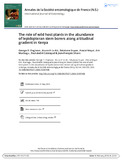Th e role of wild host plants in the abundance of lepidopteran stem borers along altitudinal gradient in Kenya

View/
Date
2006Author
Ong'amo, GO
Le Ru, Bruno P
Dupas, Stephane
Moyal, Pascal
Muchugu, Eric
Calatayud, Paul-Andre
Silvain, Jean-Francois
Type
ArticleLanguage
enMetadata
Show full item recordAbstract
Presence of wild host plants of stem borers in cereal-growing areas has been considered
as reservoirs of lepidopteran stem borers, responsible for attack of crops during the growing season.
Surveys to catalogue hosts and borers as well as to assess the abundance of the hosts were carried
out during the cropping and non-cropping seasons in different agro-ecological zones along varying
altitude gradient in Kenya. A total of 61 stem borer species belonging to families Noctuidae (25),
Crambidae (14), Pyralidae (9), Tortricidae (11) and Cossidae (2) were recovered from 42 wild plant
species. Two noctuids, Busseola fusca (Fuller), Sesamia calamistis Hampson, and two crambids,
Chilo partellus (Swinhoe) and Chilo orichalcociliellus (Strand) were the four main borer species found
associated with maize plants. In the wild, B. fusca was recovered from a limited number of host plant
species and among them were Sorghum arundinaceum (Desvaux) Stapf, Setaria megaphylla (Steudel)
T. Durand & Schinz, Arundo donax L. and Pennisetum purpureum Schumacher. In contrast, the host
range of C. partellus was considerably wider [13 for S. calamistis]. However, the number of larvae of
these species was lower in the wild compared to cultivated fi elds, thus the role of natural habitat as a
reservoir for cereal stem borers requires further studies. Importance of the wild host plants as well as
borer diversity along the altitudinal gradient is discussed.
Citation
Ann. soc. entomol. Fr. (n.s.), 2006, 42 (3-4) : 363-370Publisher
School of biological sciences
